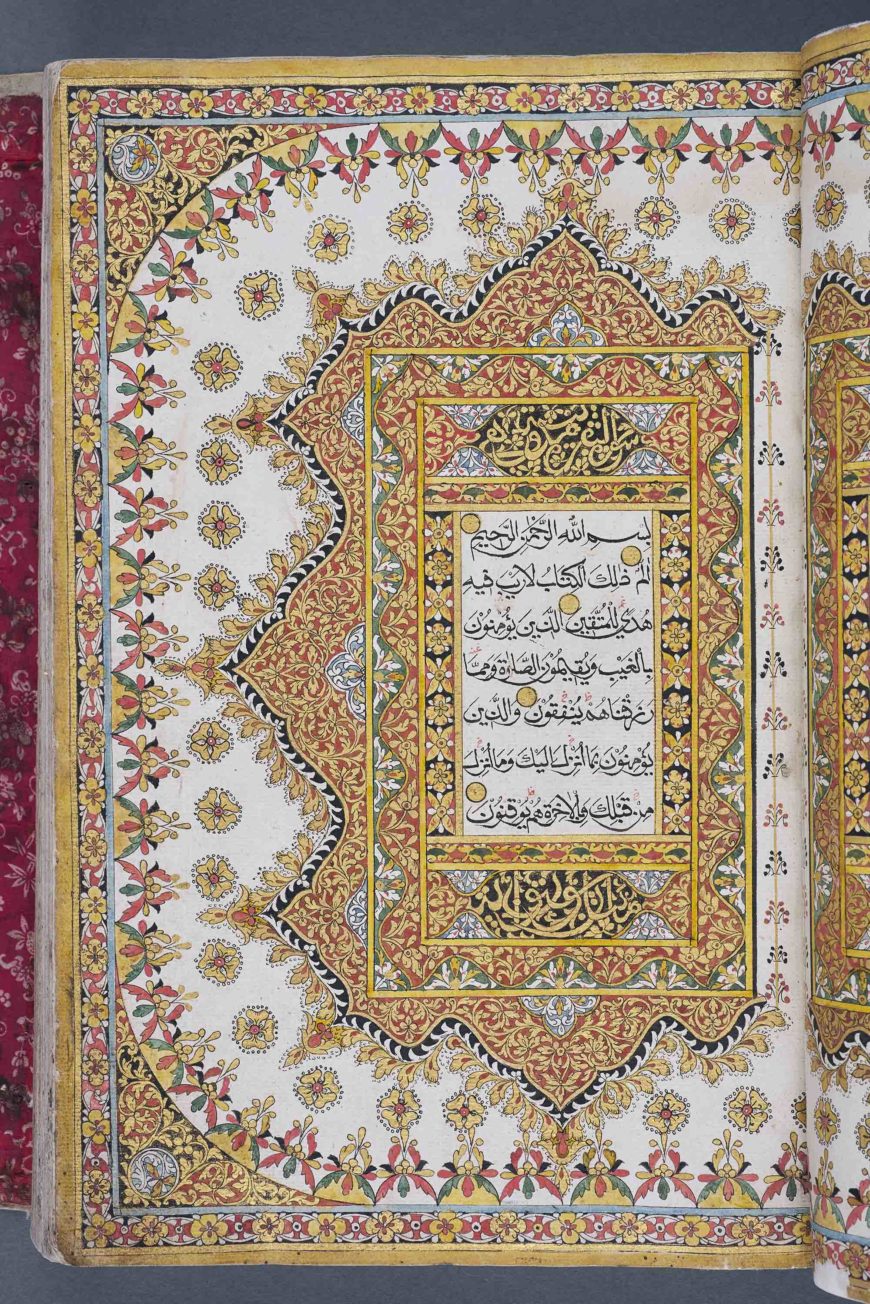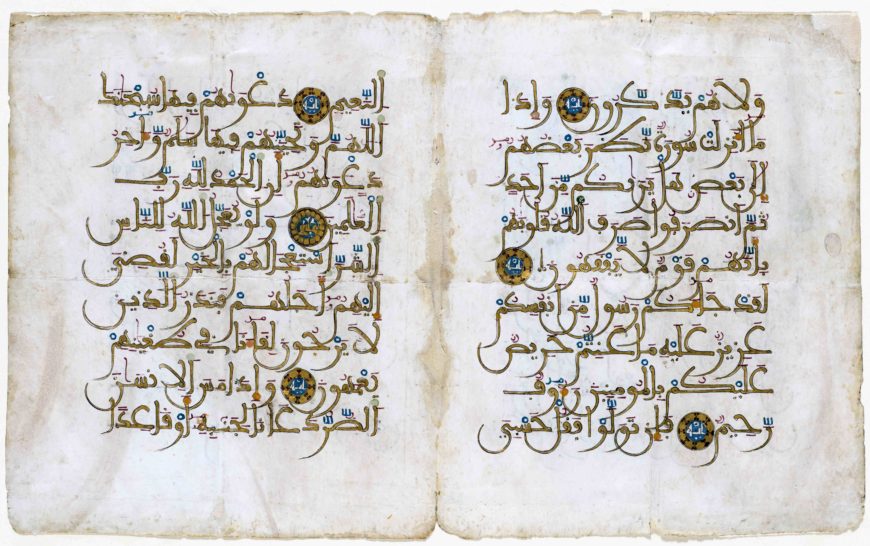
Bifolio from a Qur’an written in gold. The verse dividers consist of round medallions, while the vocalization and recitation marks are added in red, yellow, green, and blue inks. Possibly copied in Nasrid Granada, late 13th or 14th century, parchment, 27 x 22 cm (folio) (LACMA, M.2002.1.25)
Gold—unanimously recognized by Islamic sources as the most precious metal, endowed with transcendent symbolism and earthly connotations in equal measure—appears prominently in some Qur’anic manuscripts but is tantalizingly absent from others (the Qur’an is the sacred text of Islam). This leaves scholars wondering about the different intentions and sensibilities of Qur’anic calligraphers, illuminators, and their patrons, and about the religious views and anxieties shared by the societies within which the manuscripts circulated.
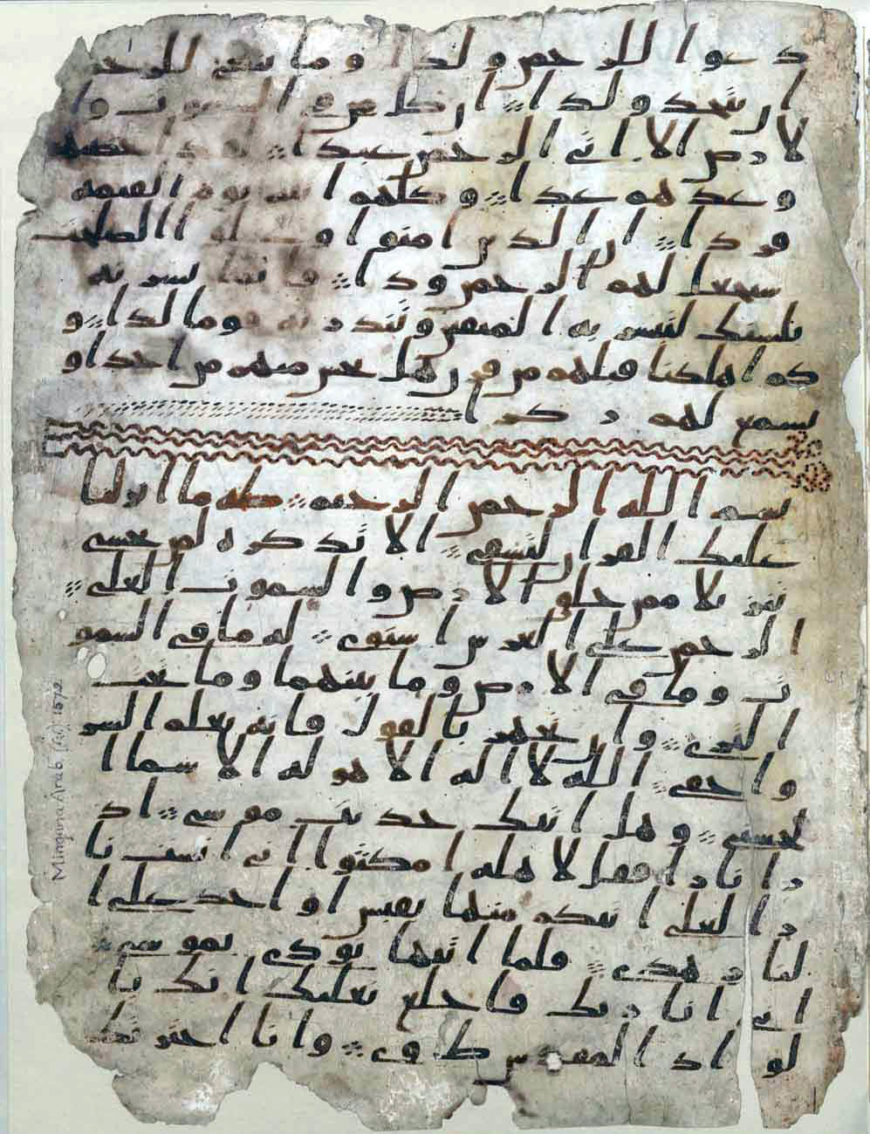
Folio from the Birmingham Qur’an, carbon-dated to the period between 568 and 645 with 95.4% probability. It is written in the so-called ‘Hijazi style’, from Hijaz, the region of Arabia where Mecca and Medina are located. Possibly Arabia, mid-7th century, parchment, 34 x 26 cm (Birmingham, Cadbury Research Library, ms. Mingana Isl. Ar. 1572a)
According to the hadiths
Several hadiths ascribed to the companions of the prophet Muhammad insist on the prohibition of writing the Qur’an in gold, embellishing it, or marking the beginning of each chapter with decorated headings. Muhammad himself is reported to have said: “If you decorate your mosques and embellish your Qur’anic manuscripts, ruin will be upon you.” [1] While it is unlikely that such concerns had already arisen among the first generation of Muslims, the earliest surviving Qur’ans penned around the mid-7th century are very austere artifacts, with ornamentation (such as verse dividers and chapter headings) kept to a bare minimum.
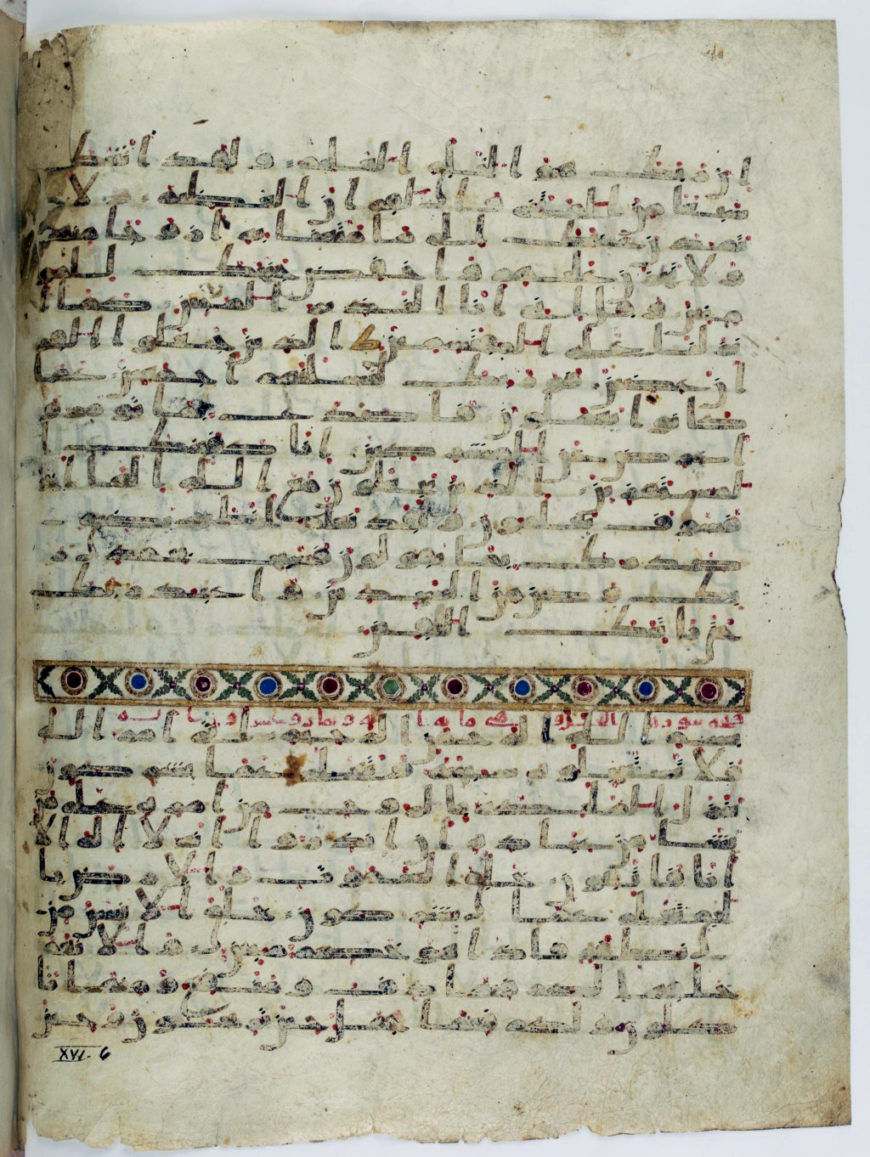
Folio from an Umayyad Qur’an with gilded verse markers and chapter dividers enhanced with gold. The vocalization consists of red dots. Possibly copied in Syria, late 7th or early 8th century, parchment, 36.5 x 28 cm (Paris, BnF, ms. arabe 330c)
Gold makes an appearance
Gold made its first appearance in Qur’anic manuscripts during the reign of the Umayyad caliphs ‘Abd al-Malik and his son al-Walid I, famous as the patrons of the Dome of the Rock and Great Mosque of Damascus respectively. This period witnessed the codification of angular Kufic scripts, as seen in the inscriptions within the Dome of the Rock, as well as in Qur’anic calligraphy. At the same time, elite Umayyad patrons sponsored the production of lavish codices that were sent and donated to the congregational mosques of the empire’s main cities. These manuscripts had to look impressive and qualitatively superior to the unauthorized versions of the Qur’an circulating at the time since they served as powerful symbols of the rulers’ piety and solicitude (care) for the Muslim community, but also of their supreme authority in doctrinal matters.
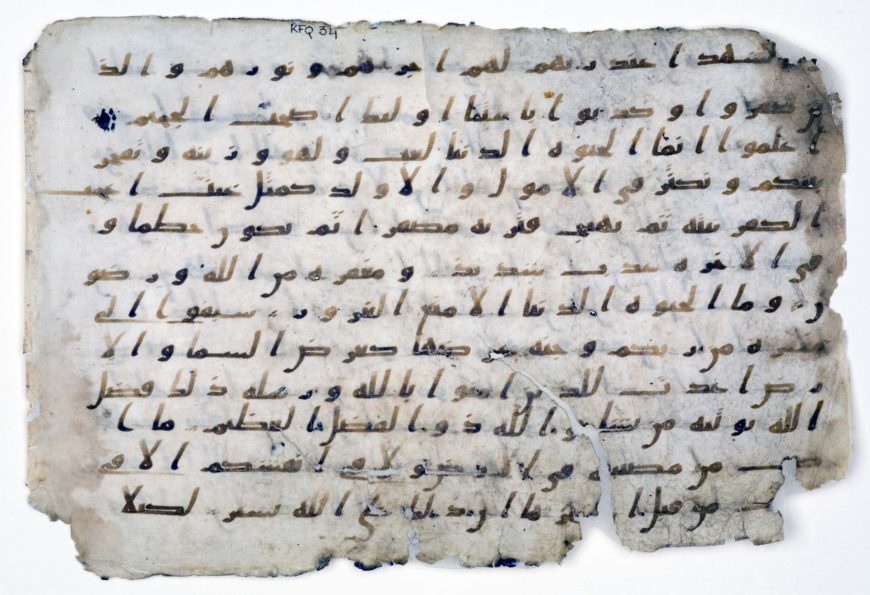
Folio from a Qur’an devoid of vocalization and illumination. Parchment, 17.5 x 25 cm. Copied in Egypt, Arabia, or Greater Syria, first half of the 8th century (London & Geneva, Khalili Collection, KFQ 34)
Another important motive behind the introduction of gold in the decoration of Qur’anic manuscripts must have been the Umayyads’ desire to rival the sophistication of contemporary Christian Bibles and Gospel Books. It is evident that some of the most lavish Qur’ans of this period were illuminated by artists trained in Byzantine (or Syriac) scriptoria, who may have been Christians or recently converted Muslims. That seems to have triggered a conservative reaction from some religious scholars of the 8th century, who advocated a clear differentiation between Qur’anic manuscripts and the sacred texts of other monotheistic traditions by means of visual austerity and the eschewal of all forms of decoration. “Strip the Qur’an bare!” [2] bluntly declared one authority, expressing a concern with ornaments and paratextual elements that was probably shared by many. These preoccupations resulted in the production of plain manuscripts devoid of color and vocalization that intentionally harked back to the starkness of the earliest Qur’ans.
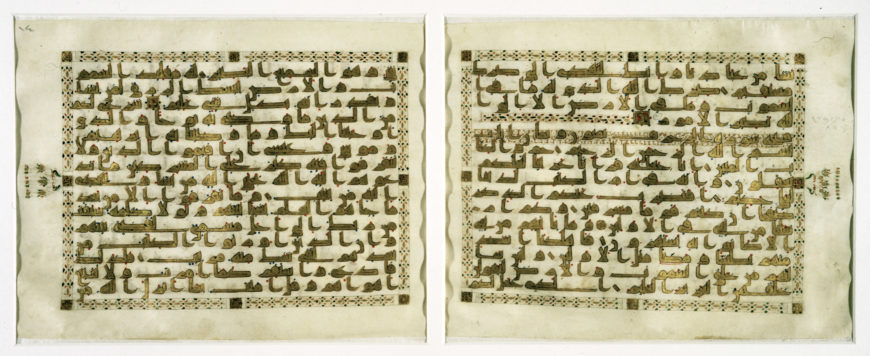
Folio from a Qur’an entirely written in gold, with blue and red dots marking the vocalization. Parchment, 27 x 36.5 cm. Possibly copied in Iraq, 9th century (Copenhagen, The David Collection)
Based in Medina, the eighth-century traditionist Malik ibn Anas disapproved of decorating the pages of the Qur’an with patterns or illumination in gold, on the grounds that they would “disturb the readers’ reflection.” [3] The fact that ornament could constitute a distraction for the pious Muslim and a hindrance to prayer was a major concern among scholars, as shown by the many attested pronouncements against the permissibility of decorating mosques, even with Qur’anic inscriptions. However, a considerable number of Qur’anic manuscripts entirely written in gold survive from the 9th century onwards. These lavish artifacts represented a striking subversion of the conservative view that material splendor could distract the heart of the faithful from the realm of the transcendental. In fact, Qur’anic chrysography aimed to embody the transcendent nature of the text, and to establish a connection between the beholder and the divine by virtue of its mesmerizing beauty. Through gold, the faithful could be engaged in acts of contemplative worship of the Word of God, in accordance with Muhammad’s pronouncement: “Give your eyes their share of worship!” [4]
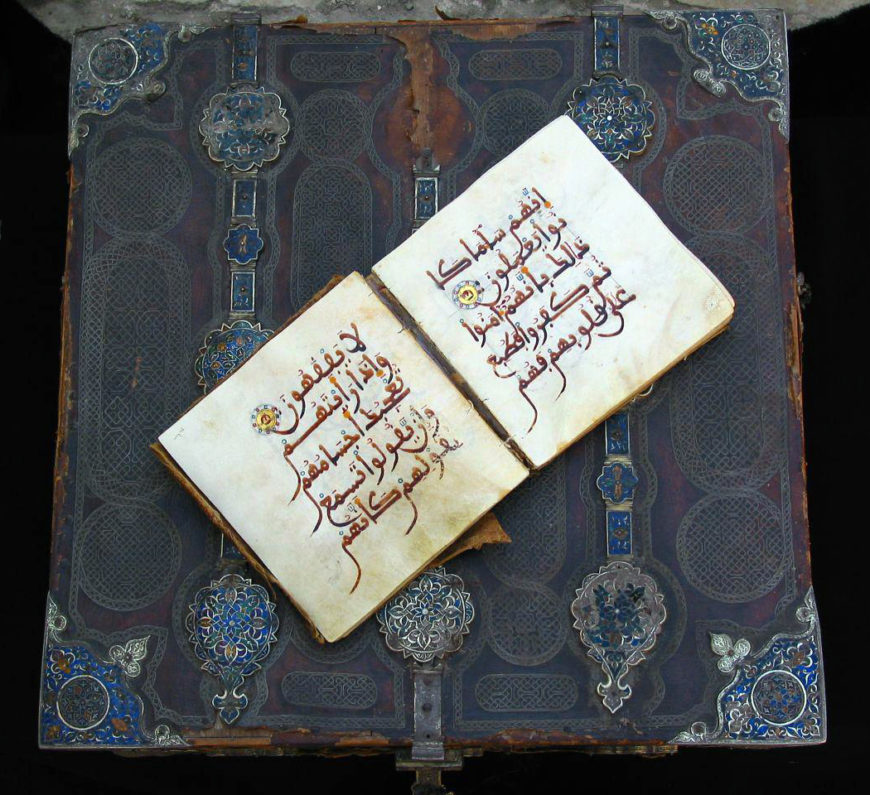
Qur’an of Abu al-Hasan, in 30 volumes, with its original wooden coffer. Parchment, 22 x 20 cm. Copied in Fes, 1344 (Jerusalem, Islamic Museum at al-Aqsa Mosque, M. Š. 30)

Wooden coffer of the Qur’an of Abu al-Hasan, made in Fes, 1344 (Jerusalem, Islamic Museum at al-Aqsa Mosque, M. Š. 30)
A compromise
Caliphs and sultans certainly understood that, when faced with so much gold, the beholder would also marvel at the wealth and prestige of the manuscripts’ patrons. Anxieties about ostentation and worldly vanity are evident from hadiths that condemn lavish illumination as a temptation to thieves. At the same time, some juridical compilations regulate the use of gold and silver in Qur’ans when discussing the permissibility of jewelry and silk clothes, which were largely forbidden for men. The fourteenth-century historian Ibn Marzuq, in his account of the noble deeds of his patron, the Moroccan sultan Abu al-Hasan, praises the sultan’s dedication to transcribing the Qur’an in his own hand, to the highest possible standards of quality. However, he also insists that Abu al-Hasan carefully avoided writing it in gold and studding it with pearls and precious stones, “so as to not pollute it with worldly adornments.” [5]
One of the Qur’ans copied by the sultan has survived in the Aqsa Mosque in Jerusalem, and while its frontispieces, colophons, sura (chapter) headings, and division markers are all lavishly gilded, the text of the Qur’an itself is penned in black ink, so, strictly speaking, the manuscript is not written in gold. The opulent wooden coffer containing the 30 volumes of this Qur’an is also decorated with applied bands, medallions, hinges, and corner pieces executed in nielloed silver, enhanced with polychrome champlevé enamel. The avoidance of gold, pearls, and precious stones may well have been intentional, and this masterpiece of the arts of the book could also be regarded as a masterpiece of compromise between pious concerns and material practices.
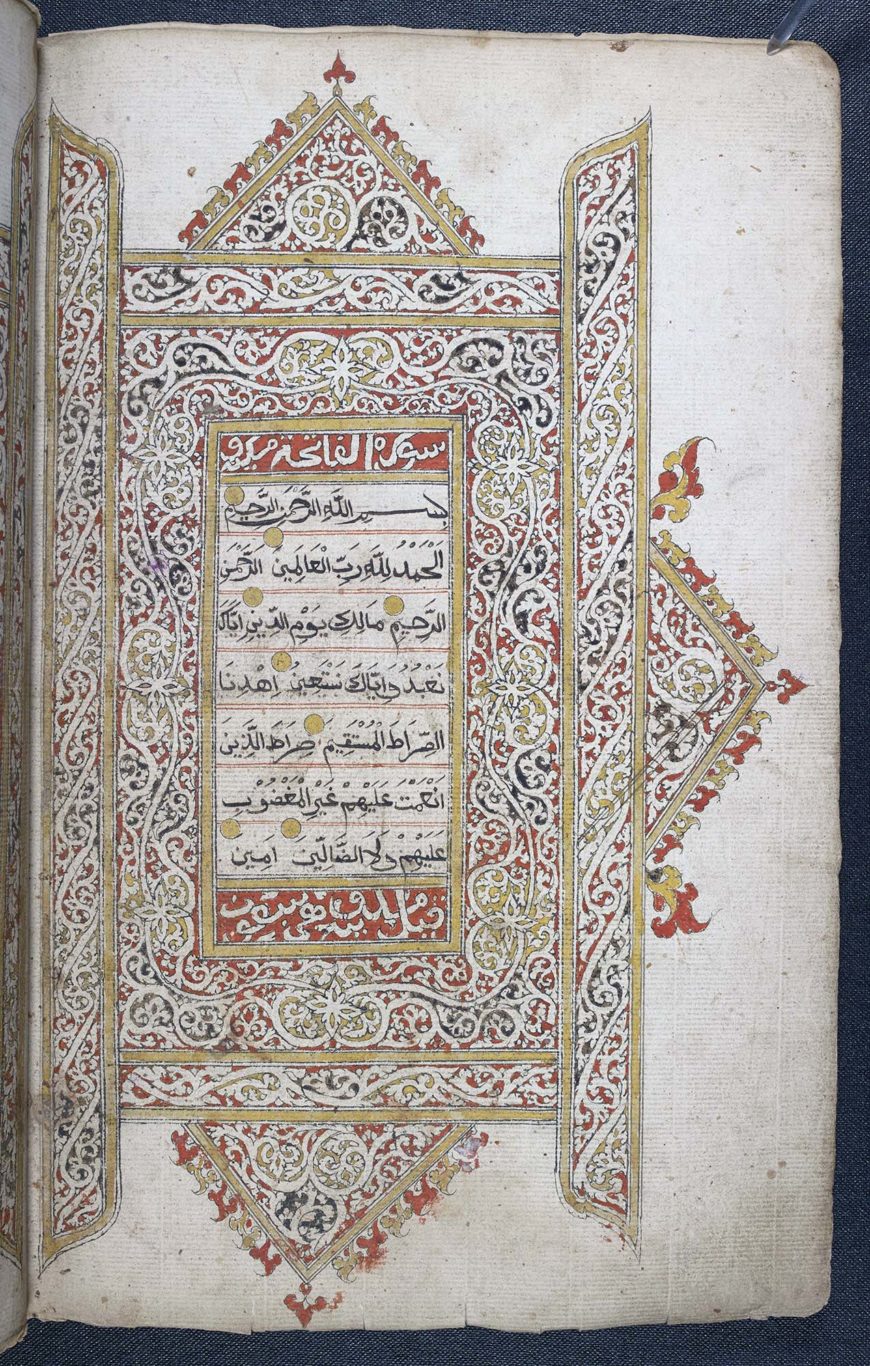
Folio from a lavishly illuminated Qur’an, though with no use of gold. Copied in Aceh, early 19th century, paper, 33 x 20.5 cm (British Library, Or. 16915)
The absence of gold
Naturally, the absence of gold from the illumination of some Qur’anic manuscripts may simply be due to its unavailability, or to the lack of technical expertise in producing gold leaf and golden inks and applying them to parchment or paper. Furthermore, in region or periods characterized by the short supply of precious metals, the use of gold in book illumination was seen as a waste of resources that could have otherwise been invested in the welfare of the Muslim community. That is evident from hadiths and juridical debates referring to the recuperation of precious metals from burning the pages of Qur’anic manuscripts (a practice allowed by some authorities).
It is often difficult to relate one or more of these concerns—be they theological, moral, aesthetic, or economic—to cases and contexts where textual evidence is wanting: how to explain, for instance, the absence of gilding from West African Qur’ans produced between the 18th and 19th centuries, even though the region was such an important source of gold? In the same period in Southeast Asia, gold illumination became the hallmark of Qur’anic manuscripts from Terengganu (eastern Malaysia), while it was seemingly never employed in Qur’ans from Aceh (northern Sumatra) for all their luxuriant, polychrome (colorful) ornamentation. Despite their cultural and geographic proximity, the artists of Terengganu and Aceh may have held different views on the aesthetic and ethical boundaries of their profession.
Divine illumination
The best-known examples of Qur’anic manuscripts produced across the Islamic world, from Morocco to Malaysia, are extremely lavish, boastful artifacts, almost defiant in their disobedience to the principles of austerity preached by the more conservative religious scholars. Gold played an important, possibly irreplaceable role in defining the aesthetics of Qur’anic calligraphy: on the one hand, as art historian Barry Flood aptly put it, it gave “visual expression to the idea of scripture as a medium of divine illumination,” while on the other, it emphasized the status of the manuscripts’ patrons, the wondrous skills of their makers, and the prestige of the mosques and libraries where they were kept. [6] The Qur’an itself (9:34) warns against the use of precious metals outside the frame of charity and righteous transactions: “And those who hoard gold and silver and spend it not in the way of God—give them tidings of a painful punishment”. Despite the opposition of some jurist and traditionists, enhancing the Word of God with gold was evidently considered a worthy endeavor by many, and a legitimate expenditure of money and effort in pursuit of earthly recognition and divine beauty.

